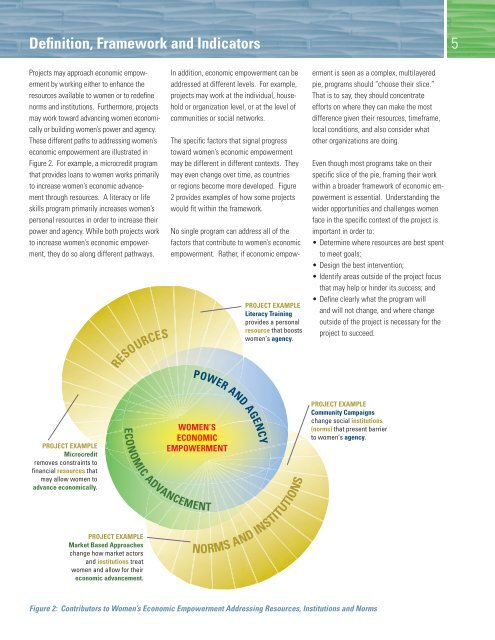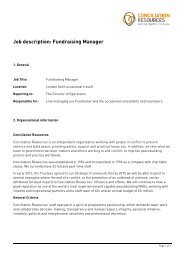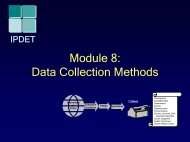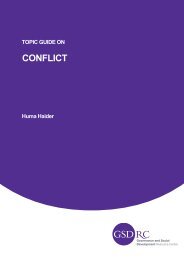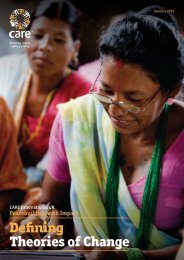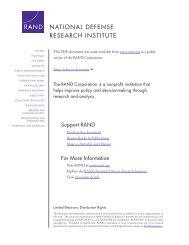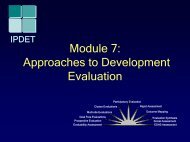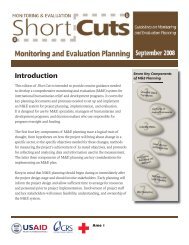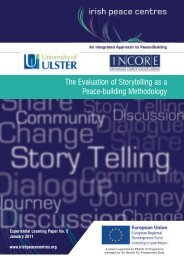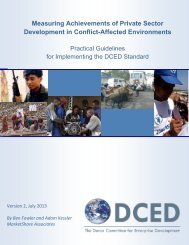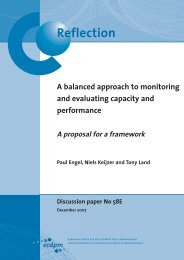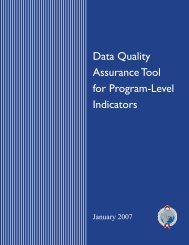Understanding and measuring womens economic ... - ICRW
Understanding and measuring womens economic ... - ICRW
Understanding and measuring womens economic ... - ICRW
You also want an ePaper? Increase the reach of your titles
YUMPU automatically turns print PDFs into web optimized ePapers that Google loves.
Definition, Framework <strong>and</strong> Indicators5Projects may approach <strong>economic</strong> empowermentby working either to enhance theresources available to women or to redefinenorms <strong>and</strong> institutions. Furthermore, projectsmay work toward advancing women <strong>economic</strong>allyor building women’s power <strong>and</strong> agency.These different paths to addressing women’s<strong>economic</strong> empowerment are illustrated inFigure 2. For example, a microcredit programthat provides loans to women works primarilyto increase women’s <strong>economic</strong> advancementthrough resources. A literacy or lifeskills program primarily increases women’spersonal resources in order to increase theirpower <strong>and</strong> agency. While both projects workto increase women’s <strong>economic</strong> empowerment,they do so along different pathways.110613 <strong>ICRW</strong> Folder graphics B G Y:11-0 10/5/11 12:09 PM Page 2RESOURCESIn addition, <strong>economic</strong> empowerment can beaddressed at different levels. For example,projects may work at the individual, householdor organization level, or at the level ofcommunities or social networks.The specific factors that signal progresstoward women’s <strong>economic</strong> empowermentmay be different in different contexts. Theymay even change over time, as countriesor regions become more developed. Figure2 provides examples of how some projectswould fit within the framework.PROJECT EXAMPLELiteracy Trainingprovides a personalresource that boostswomen’s agency.No single program can address all of thefactors that contribute to women’s <strong>economic</strong>empowerment. Rather, if <strong>economic</strong> empowermentis seen as a complex, multilayeredpie, programs should “choose their slice.”That is to say, they should concentrateefforts on where they can make the mostdifference given their resources, timeframe,local conditions, <strong>and</strong> also consider whatother organizations are doing.Even though most programs take on theirspecific slice of the pie, framing their workwithin a broader framework of <strong>economic</strong> empowermentis essential. <strong>Underst<strong>and</strong>ing</strong> thewider opportunities <strong>and</strong> challenges womenface in the specific context of the project isimportant in order to:• Determine where resources are best spentto meet goals;• Design the best intervention;• Identify areas outside of the project focusthat may help or hinder its success; <strong>and</strong>• Define clearly what the program will<strong>and</strong> will not change, <strong>and</strong> where changeoutside of the project is necessary for theproject to succeed.POWER AND AGENCYPROJECT EXAMPLEMicrocreditremoves constraints tofinancial resources thatmay allow women toadvance <strong>economic</strong>ally.PROJECT EXAMPLEMarket Based Approacheschange how market actors<strong>and</strong> institutions treatwomen <strong>and</strong> allow for their<strong>economic</strong> advancement.WOMEN’SECONOMICEMPOWERMENTECONOMIC ADVANCEMENTNORMS AND INSTITUTIONSPROJECT EXAMPLECommunity Campaignschange social institutions(norms) that present barriersto women’s agency.Figure 2: Contributors to Women’s Economic Empowerment Addressing Resources, Institutions <strong>and</strong> Norms


